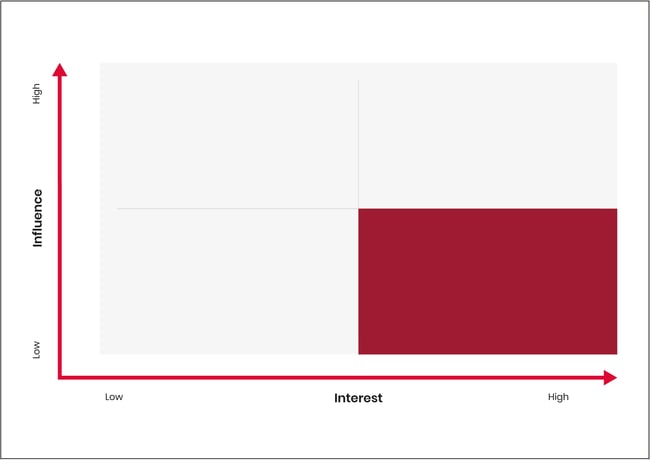This blog post is the third article of a 4-part series entitled Beyond Stakeholder Mapping, which aims to explore the engagement dynamics and specificities each quadrant requires in the stakeholder mapping journey.
You can access the other articles here: Part 1 | Part 2 | Part 4, or download the guide with all articles here:
Highly interested and low-influencer stakeholders: the low-influence/high-interest quadrant
In many ways, this is the most valuable product of a stakeholder mapping exercise, and traditionally, we have always advised consultants to ensure that individuals within this quadrant get an adequate opportunity to respond.
It is time to go further and declare that this is no longer a ‘nice to do’ but an essential outcome of the exercise.
After all, the purpose of stakeholder mapping is to identify who is out there and needs to be engaged in any process of relevant decision-making.

The first thing to note is that it is much easier to assess the influence axis. They represent forces that matter – big employers, municipal leaders, local personalities and of course the media.
Over the years, we have all come to realise that the biggest weakness of decision-making – whether in the public, private or third-party sector – is the lack of robust impact assessments.
Too many policies are proposed and plans adopted without a sufficiently researched analysis of who is affected.
It starts at the top, with largely inadequate, formulaic assessments produced by Ministers as they introduce legislation in Parliament. Right down through the myriad of public bodies, there is too much reliance on desk research – often by inexperienced staff or those unfamiliar with the relevant domain expertise.
In reality, there are a host of tried and tested techniques to identify those most impacted by the proposed change.
Personally, I always liked using DILO. For this, you imagined or assembled individuals to go through A Day in the Life Of … a stakeholder. What will be different? What would be better? And what would be worse?
Before long, one discovers that so variable are the circumstances that there are huge differences in the likely implications for people, from mild inconvenience to almost existential threats to an organisation’s raison d’etre or someone’s way of life.
The key characteristic of those in the High-interest/Low-influence category is that, lacking influence, they are seldom in a position to articulate these concerns.
Some of those who may be most impacted are literally ‘below the radar’ – rarely visible to the bureaucratic mindset, or maybe exhibiting unusual or unrecognised behaviours.
Unsurprisingly, therefore, this category regularly features minority or disadvantaged groups like small ethnic or linguistic communities, those with less common disabilities or traveller groups.
Because some charities and pressure groups nationally have a high profile, it is no guarantee that the interests of particular stakeholders in more local situations will necessarily be heard.
So for those in this quadrant, the onus is on the organisation contemplating change to be proactive and to find who is there. By definition, if they have low influence, you must make the effort and spend the money to discover their identities. This is often controversial.
High-octane leaders, keen to make progress and secure change, with or without consultation, are not attracted to the delay and the cost of undertaking research into the disadvantages of their own schemes.
Ironically, even a cursory analysis will often identify straightforward mitigation measures that could make a real difference to those otherwise badly affected.
If ever there is a case for co-production – working with those likely to be impacted to reduce harm and seek consensus, this is it.
The Impact Assessment is almost certainly only as good as the extent to which you have built a dialogue with the High/Low stakeholders.
Once you start looking, you may be surprised how many there may be. And one needs to keep looking. Many in this category are transitory; people or groups who get together just for the occasion of responding to what they perceive as a threat.
Because they are less accustomed to the social dynamics or the relevant politics, there is much scope for simple misunderstandings – and anxieties that can be dispelled relatively easily.
This is the opportunity to focus on innovative engagement techniques, more accessible communication tools and specialist community outreach initiatives.
Over the years, when asked for an opinion on a current or forthcoming consultation, I have tended to rely considerably upon the answer to two questions: Who is most adversely affected by your proposals? And how are you dealing with them?
The credibility of the answers usually reflects how well a stakeholder mapping exercise has been done – and how much attention has been paid to the crucial High/Low category.
In the final article, we explore the Low Influence/Low Interest category.
Download the Beyond Stakeholder Mapping Guide:



